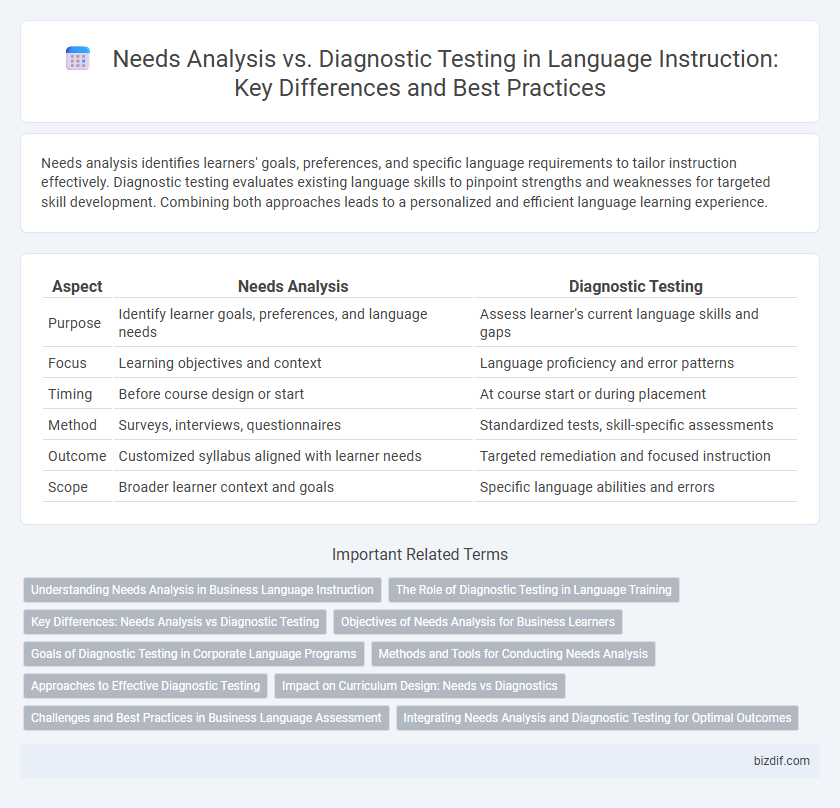Needs analysis identifies learners' goals, preferences, and specific language requirements to tailor instruction effectively. Diagnostic testing evaluates existing language skills to pinpoint strengths and weaknesses for targeted skill development. Combining both approaches leads to a personalized and efficient language learning experience.
Table of Comparison
| Aspect | Needs Analysis | Diagnostic Testing |
|---|---|---|
| Purpose | Identify learner goals, preferences, and language needs | Assess learner's current language skills and gaps |
| Focus | Learning objectives and context | Language proficiency and error patterns |
| Timing | Before course design or start | At course start or during placement |
| Method | Surveys, interviews, questionnaires | Standardized tests, skill-specific assessments |
| Outcome | Customized syllabus aligned with learner needs | Targeted remediation and focused instruction |
| Scope | Broader learner context and goals | Specific language abilities and errors |
Understanding Needs Analysis in Business Language Instruction
Needs analysis in business language instruction identifies specific language skills and communication contexts essential for employees, guiding targeted course design to enhance workplace performance. Unlike diagnostic testing, which assesses current proficiency levels to locate gaps, needs analysis delves deeper into job roles, industry terminology, and interaction types to customize learning objectives. Implementing a thorough needs analysis ensures training aligns with organizational goals, optimizing language acquisition for real-world business situations.
The Role of Diagnostic Testing in Language Training
Diagnostic testing plays a crucial role in language training by identifying learners' existing proficiency levels, strengths, and weaknesses. Unlike needs analysis, which focuses on learners' goals and contextual requirements, diagnostic tests provide specific data on linguistic skills such as grammar, vocabulary, pronunciation, and comprehension. This targeted assessment allows educators to design personalized instruction plans that address gaps and accelerate language acquisition effectively.
Key Differences: Needs Analysis vs Diagnostic Testing
Needs analysis identifies learners' goals, preferences, and motivations to tailor language instruction effectively, focusing on future learning requirements. Diagnostic testing evaluates current language proficiency, pinpointing specific strengths and weaknesses to address immediate learning gaps. Together, these tools optimize curriculum design by aligning learner needs with targeted skill development.
Objectives of Needs Analysis for Business Learners
Needs analysis for business learners targets identifying specific language skills required to achieve professional goals, such as negotiation, presentations, and report writing. It evaluates learner profiles, workplace communication demands, and industry-specific vocabulary to tailor instructional content. This strategic assessment ensures that language training aligns with organizational objectives and enhances learner effectiveness in real business contexts.
Goals of Diagnostic Testing in Corporate Language Programs
Diagnostic testing in corporate language programs aims to identify employees' current proficiency levels and specific skill gaps to tailor training effectively. It provides precise data on individual strengths and weaknesses, enabling targeted curriculum development that aligns with organizational communication needs. This focused assessment enhances training efficiency, ensuring measurable progress toward business language objectives.
Methods and Tools for Conducting Needs Analysis
Needs analysis employs qualitative methods like interviews, focus groups, and observations alongside quantitative tools such as surveys and questionnaires to identify learners' goals, preferences, and language requirements. Diagnostic testing, by contrast, utilizes standardized assessments and proficiency tests specifically designed to pinpoint learners' strengths and weaknesses in language skills. Effective needs analysis integrates multiple data sources to create a comprehensive profile that guides curriculum design and instructional priorities.
Approaches to Effective Diagnostic Testing
Effective diagnostic testing in language instruction centers on precise learner profiling through needs analysis and targeted skill assessment. Utilizing approaches such as task-based evaluation and error analysis enhances the identification of individual language gaps, enabling tailored instructional strategies. Implementing adaptive testing technology further refines diagnostic accuracy by dynamically adjusting to learner responses and proficiency levels.
Impact on Curriculum Design: Needs vs Diagnostics
Needs analysis provides detailed insights into learners' goals, preferences, and language use contexts, enabling curriculum designers to tailor content for relevance and motivation. Diagnostic testing identifies learners' specific language strengths and weaknesses, guiding precise adjustments in curriculum sequence and difficulty level. Balancing needs analysis and diagnostic testing results ensures a curriculum that is both engaging and efficiently targeted to improve language proficiency.
Challenges and Best Practices in Business Language Assessment
Challenges in business language assessment stem from accurately identifying learners' communicative competencies and specific workplace language needs during needs analysis, which often involves subjective self-reporting and varying organizational goals. Diagnostic testing offers objective measurement of language skills but struggles to capture contextual nuances and professional jargon essential for effective business communication. Best practices combine thorough needs analysis with tailored diagnostic tools, ensuring assessments align with real-world tasks and industry-specific language demands to optimize language instruction outcomes.
Integrating Needs Analysis and Diagnostic Testing for Optimal Outcomes
Integrating needs analysis and diagnostic testing in language instruction enhances personalized learning by identifying students' goals, preferences, and proficiency gaps. Needs analysis gathers detailed information on learners' objectives and context, while diagnostic tests assess current skills and knowledge levels. Combining these approaches allows educators to create targeted curricula that address specific weaknesses and align with learners' aspirations, optimizing overall language acquisition outcomes.
Needs Analysis vs Diagnostic Testing Infographic

 bizdif.com
bizdif.com